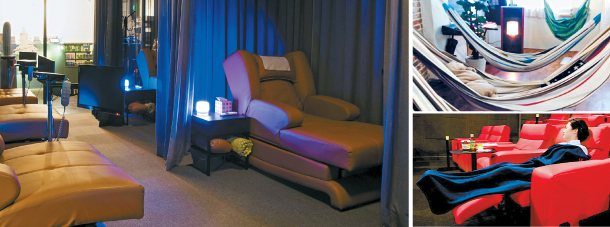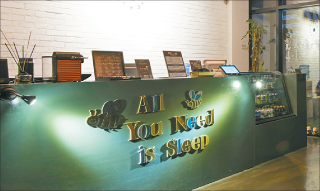A quiet cave in the middle of the bustling city : Sleep cafes offer beds to anyone looking for a peaceful place to nap

Left: Beds in sleep cafe Kkooljam24 are divided by curtains, guaranteeing private space for each visitor. Top right: Nazzzam, a sleep cafe located in Jongno District gives visitors the choice of whether to sleep in a hammock, a sofa or a bed. Bottom right: CGV Yeouido opens up their theater sofas for those looking for a midday nap from Monday through Thursday. [POOL, SCREEN CAPTURE, CGV YEOUIDO]
A 28-year-old worker surnamed Kim also visits a nearby sleep cafe more than once a week. “Although I drink a cup of coffee every morning after arriving at my office, I still feel sleepy, so I often visit the sleep cafe during my lunch break,” she said. “If I drink a hot tea in the massage chair, the rest of my day becomes fresher.”
Sleep cafes are now popular among office workers in their 20s and 30s. When they visit, guests can temporarily relieve stress from excessive working, or alleviate fatigue from the company dinner that ended late the night before. Private space is guaranteed at most of the sleep cafes so visitors don’t have to worry about running into colleagues while they enjoy their break. The cafes are mostly located in dense business districts like Gangnam District in southern Seoul or Jongno District in central Seoul. There are some places that operate 24 hours a day so that workers laboring into the early morning hours can stop by for a nap before heading back into the office.
The JoongAng Ilbo visited Kkooljam24, a sleep cafe in Gangnam. Once a guest comes into the cafe, the staff provides them with sandals. The space is dark but comfortable and relaxing white noise creates a soothing mood. The cafe feels like a cave in the middle of the bustling city. The phrase, “All you need is sleep” is written across the front counter.

The phrase “All you need is sleep,” is written across the front counter at Kkooljam24, a sleep cafe located in Gangnam District, southern Seoul. [POOL]
An hour at the Gangnam cafe is 5,500 won ($5.07) while two hours will cost 9,900 won. An 11-hour pass is also available for 15,000 won. Depending on the store, a beverage is included in the price as well.
Nazzzam, a sleep cafe located in Jongno, provides a beverage and offers an hour of rest for 6,000 won. Here, the guest is given a choice whether to sleep on a bed, a sofa or a hammock. No one should worry that they won’t be able to wake up on time because the staff will wake guests up if requested.
Roh Woong-hyun, the owner of the sleep cafe in Gangnam, said that on average, approximately 50 to 60 people visit each weekday - most of whom are office workers in their 20s and 30s.
“These days, people in their 40s and 50s also visit the cafe often. Since we are open for 24 hours, workers who stay up all night stop by the cafe and teenagers that visit Seoul for concerts from other cities also visit the cafe,” said Roh. He then revealed his plan to open up another shop. The cafe first opened in September 2016.
According to data from Shinhan Card published in June, people in their 20s took up 63 percent of the total visitors of so-called “healing cafes” including sleeping cafes in 2016. In about a year, people in their 30s and 40s have started visiting as well, with the amount of customers in those age ranges going up by 199 percent and 209 percent, respectively.
As demand for taking a nap during lunch hours has spiked, movie theaters have begun to open up their theaters so that workers nearby theaters can get some shut-eye.
Theater chain CGV’s Yeouido location in western Seoul, has been operating its “Siesta Program” since March 2016, which opens up the theater’s premium seating for those looking for some extra midday sleep. The program operates from Monday to Thursday between 11:30 a.m. and 1 p.m. The seats lay flat and guests are provided with a blanket, a cup of herb tea and a pair of sandals. Light classical music is played throughout the nap time. The program’s price is 10,000 won for a 90-minute stay.
Experts point out that this “10,000-won happiness” phenomenon, where people find stress relief for a reasonable price, is the result of excessive labor hours.
According to 2016 data from the Organization for Economic Cooperation and Development the average Korean spends 7 hours and 41 minutes sleeping, which is 40 minutes less than the average in the rest of the OECD. Based on 2016 data, Koreans spend a total of 2,069 hours working per year, the second-highest in the OECD after Mexico.
Professor Kwon Soon-won from the business administration department of Sookmyung Women’s University said, “Korea’s corporate culture is centered on hiring the minimum number of people and having them work at their maximum potential. Most of the time, leaving the office on time is difficult and dinner gatherings go late into the night. Productivity naturally falls when the work hours are longer and sleep is decreased.”
“In Europe, guaranteeing a break has been an issue. There should be discussions about cutting the number of hours people work in Korea as well,” added Kwon.
As Greek poet Homer (750 BCE) wrote in the epic “The Odyssey,” “For sleep makes one forget all things, the good and the evil, when once it envelops the eyelids.” Koreans often relieve their stress by taking a quick nap.
“Some people choose to eat alone because eating with others can be tiresome as well. But even eating alone can be tiring sometimes,” said a guest, surnamed Lee, who recently visited a sleep cafe. “Those days, I visit this cafe and take a nap because I just need some sleep and I need a break from work,” she added.
BY YU SUNG-KUK [hong.youkyoung@joongang.co.kr]
6000원이면 한 시간 꿀잠 … 야근·회식에 지친 몸 가뿐
서울 강남구에서 일하는 회사원 박모(30)씨는 최근 회사 근처에 ‘아지트’를 마련했다. 늦은 밤까지 회식이 많고 업무 특성상 외근이 잦은 그는 점심시간이면 그곳을 찾는다. 바로 수면 카페다. 박씨는 “원래는 점심시간에 사우나에 갔다. 그런데 얼마 전 사우나에서 부장님을 본 이후 괜히 눈치가 보여 대안을 마련했다”고 말했다. 그는 “조용하고 쾌적해 한숨 자고 회사에 들어가기 좋다”고 말했다.
직장인 김모(28·여)씨는 1주일에 한 번 이상 점심시간에 인근 수면카페를 이용한다. 김씨는 “아침에 출근해 커피를 마셔도 졸린 건 어쩔 수 없다. 점심시간에 종종 수면카페에 간다. ‘스튜핏(stupid)’ 소비인 건 알지만 어쩔 수 없다. 안마의자에 앉아 차를 한잔 마시며 눈을 붙이면 남은 하루가 개운하다”고 말했다.
최근 20~30대 직장인 사이에서 주목받는 수면카페는 힐링 카페 등으로 불린다. 한 시간 남짓의 점심시간을 이용해 전날 야근과 회식의 피로를 푼다. 대부분 커튼으로 개인 공간이 보장된다. 상사나 선·후배를 마주칠 위험도 적다.
수면카페는 사무실이 밀집한 서울 종로와 강남 일대에서 성업 중이다. 24시간 시스템으로 운영하는 곳도 있다. 점심시간뿐 아니라 밤샘 야근 중에 잠시 찾아 밀린 잠을 보충하는 이들도 있다.
지난 화요일 오후 1시에 방문한 강남의 한 수면카페. 입구에서 슬리퍼로 갈아 신고 문을 열고 들어가니 약간 어둡고 아늑한 분위기의 공간이 나왔다. 나직한 백색소음이 들리는 지하 1층의 공간은 도심 속 동굴 같은 느낌이었다. 계산대 앞에는 “All you need is sleep.” 이란 재치 있는 문구가 붙어 있다.
인사를 하고 요금을 물으니 프런트 직원은 자신의 검지를 입에 가져가 ‘쉿’ 모양을 했다. 속삭이듯 “계산은 나중에 하시면 되고요, 안내해 드릴게요”라고 말했다.
직원의 안내를 따라가는 통로에는 개별공간을 나누는 커튼이 쳐져 있다. 널따란 베이지색 가죽 침대가 보인다. 직원이 간단하게 리모컨으로 침대를 조작하는 법을 설명하고는 커튼을 치고 돌아갔다. 좌우에서는 낮잠을 자는 이들의 크고 작은 숨소리가 들렸다.
이 카페의 이용요금은 1시간에 5500원, 2시간에 9900원이다. 1만5000원이면 11시간의 야간 정액권을 구입할 수 있다. 대부분의 수면카페는 이용요금이 1만원 안팎이다. 업소에 따라 기본으로 음료를 제공하기도 한다. 종로에 있는 수면카페는 6000원에 한 시간 동안 이용할 수 있고 음료 1잔이 서비스된다. 침대 대신 소파나 해먹에서 낮잠을 잘 수 있다. 일부 업소는 수면바지를 주기도 한다. 늦잠을 잘까 봐 걱정할 필요는 없다. 미리 퇴실 시간을 말하면 ‘알람’처럼 직원이 깨워 준다.
강남의 G수면카페 공동대표인 노웅현(45)씨는 “평일 기준으로 하루 50~60명 정도가 방문한다. 점심시간은 20~30대 회사원이 대부분이다”고 말했다. 노씨는 “최근에는 40~50대도 많이 찾는다. 24시간 운영하다 보니 야근을 하다 와서 쪽잠을 자는 직장인도 많고, 지방에서 콘서트 등을 보러 왔다가 잠을 자고 돌아가는 10대들도 종종 있다”고 했다. 지난해 9월에 문을 연 노씨는 “매출이 나쁘지 않아 곧 2호점을 낼 계획이다”고 덧붙였다.
신한카드 트렌드연구소에 따르면 지난 6월 신한카드 이용 내역 빅데이터를 분석한 결과 2016년 기준으로 수면 등 힐링카페 이용자는 20대가 63%를 차지해 가장 많았다. 1년 사이에 30대(199%)와 40대(209%)의 이용 건수도 급증했다.
점심시간 낮잠에 대한 수요가 늘면서 멀티플렉스 상영관에도 새로운 문화가 생겨나고 있다. 서울 여의도 CGV는 지난 3월부터 매주 월~목요일 정오부터 오후 1시까지 ‘시에스타 프로그램’을 운영한다. 180도 젖혀지는 리클라이너 좌석에 클래식 음악과 담요, 허브차, 슬리퍼 등이 제공된다.
운영시간은 매주 월요일부터 목요일, 오전 11시 반부터 오후 1시까지다. 리클라이너 좌석이 비치된 프리미엄관(7관)에서 최대 90분 동안 낮잠을 즐길 수 있다. 좌석 대여를 포함해 음료, 담요, 슬리퍼를 제공한다. 이용 가격은 1만 원이다.
수면카페와 영화관에서 ‘만원의 행복’을 찾는 직장인이 늘어나는 것에 대해 전문가들은 긴 노동시간과 기업문화 때문이라고 지적한다.
지난해 경제협력개발기구(OECD) 통계에 따르면 한국인의 하루 평균 수면시간은 7시간41분. OECD 평균보다 40분이 짧다. 노동시간은 2016년 기준 2069시간으로 OECD 국가 중 멕시코에 이어 둘째로 길다. 전체 평균과 비교할 때 305시간이 많고 일본과 비교하면 매년 44일을 더 일한다.
‘더 일하고 덜 자는’ 한국인의 삶은 커피 소비량에서도 나타난다. 우리나라 성인 1인당 연간 커피 소비량은 400잔을 넘는다. 커피 시장 규모도 2014년부터 연평균 9.3% 커졌다.
권순원 숙명여대 경영학과 교수는 “우리나라는 최소한의 인원을 뽑아 최대한의 일을 시키는 기업문화가 있다. 또 상사의 눈치로 ‘칼퇴’는 어렵고 회식은 길게 이어진다. 생산성은 떨어지고 노동시간은 길고, 수면시간은 부족할 수밖에 없다”고 말했다.
권 교수는 “유럽의 경우 최근 연속 휴게시간 보장이 이슈다. 업종에 따라 퇴근한 이후 다음날 출근까지 연속 휴게시간을 정해 휴식을 제도적으로 보장하는 취지다. 근로시간 단축 논의와 함께 이런 부분에 대한 논의가 필요하다”고 지적했다.
잠이 부족한 직장인들은 오늘도 수면 카페로 향한다. 고대 그리스 시인 호메로스가 “잠은 눈꺼풀을 덮어 선한 것, 악한 것, 모든 것을 잊게 하는 것”이라고 노래한 것처럼 한국의 직장인들은 서툰 실수로, 상사의 지적으로 쌓인 스트레스를 낮잠으로 푼다.
“왜 사람들이랑 밥먹는 것도 귀찮아서 ‘혼밥’할 때가 있잖아요. 가끔은 ‘혼밥’마저 피곤할 때가 있어요.” 수면카페 입구에서 검은색 구두로 갈아 신고 회사로 돌아갈 채비를 하던 직장인 이모(29·여)씨가 말했다. “그럴 때 수면카페에서 아무 생각 없이 자고 가요.” 피곤하니까. 쉬어야 하니까. 잊어야 하니까.
여성국기자










with the Korea JoongAng Daily
To write comments, please log in to one of the accounts.
Standards Board Policy (0/250자)